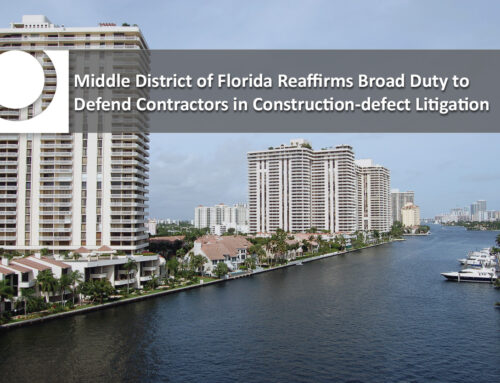Last week, a federal district court in Florida reaffirmed the black-letter law in Florida that claims against a general contractor for damage to the completed project resulting from the defective work of a subcontractor constitutes “property damage” under a Commercial General Liability, or “CGL,” policy. The order also clarifies how “other insurance” clauses are construed when insurers offer competing arguments about who has to pay first — a common dispute in multiparty, multipolicy cases.
In Pavarini Construction Co. v. ACE American Ins. Co. (Feb. 25, 2015), Pavarini, the insured, was the general contractor for a 63-floor, mixed-use condominium tower. As is customary in projects of this size, Pavarini hired several subcontractors to perform the work. The steel subcontractor’s deficient work at issue in this case involved missing and misplaced reinforcing steel in the concrete masonry unit. This deficient work caused excess movement in the building, resulting in damage to exterior stucco, water intrusion in the penthouse enclosure, and cracking in the concrete columns, beams, and shear walls.
Pavarini paid tens of millions of dollars to repair the damage caused by the missing and misplaced reinforcing steel. It then tendered a claim for indemnification to its primary liability insurer, American Home, its excess liability insurer, ACE, and its “Subguard” insurer (more on that below), Steadfast. American Home paid $2 million (its policy limits), but ACE refused to pay for any costs associated with the repairs. Steadfast also funded some of the repairs under an agreement with Pavarini to be repaid from any recovery against ACE. Pavarini sued ACE to recover more than $23 million in costs, fees, and interest.
ACE moved for summary judgment against Pavarini’s coverage claims, arguing that there was no coverage under the ACE excess policy because the claim was not for covered “property damage” but rather to repair a subcontractor’s deficient work. Pavarini responded by clarifying that that it sought reimbursement for property damage to other parts of the building “resulting from” the steel subcontractor’s defective work— not for the repair of the defective work itself. In other words, Pavarini did not seek reimbursement to repair the missing and misplaced reinforcing steel, but rather for damage caused by these defects to the stucco, concrete columns, and other parts of the condominium building.
The court agreed with Pavarini and denied ACE’s motion for summary judgment: “These assertions, supported by affidavit, create an issue of fact. If credited by the factfinder, they show that Pavarini’s repairs were of property damage caused by defective work — as opposed to repairs of the defective work itself.” (Emphasis added).
The quoted language above is significant because it reaffirms well-established Florida state law that property damage caused by one subcontractor’s defective work to other property is covered property damage under a liability policy. But it also serves as a reminder to insureds (and their attorneys) to carefully draft the complaint against the insurer. It is paramount that the insured allege damage to property other than the defective work itself.
Another issue was whether ACE’s policy was excess to the “Subguard” policy issued by Steadfast to Pavarini (that is, whether ACE’s coverage would kick in only after the Steadfast policy limits were exhausted). A Subguard policy (also known as subcontractor-default insurance) is an alternative to performance bonds. A Subguard policy is intended to protect a general contractor against defaults by subcontractors by reimbursing the general contractor for the costs incurred because of a subcontractor’s default.
ACE argued that its liability policy was excess over both the primary liability policy issued by American Home and the Subguard policy issued by Steadfast and, accordingly, that both of these policies must be exhausted before the ACE’s coverage obligations could be triggered. Specifically, ACE argued that the “Other Insurance” provision in the Subguard policy put Steadfast first in line to pay: “This insurance shall be excess only and non-contributing over any other valid and collectible insurance available to you…unless such other insurance is written only as a specific excess insurance over the limits of insurance provided in this Policy.” (Emphasis added).
The court found that this clause could not possibly be read as ACE suggested: “This argument fails. Under no reading of the ACE policy is it written only as a specific excess insurance over the limits of insurance provided in the Subguard policy.” (Emphasis in original). Rather, as the court had noted earlier in the opinion, the ACE policy provided that it was excess over “UNDERLYING INSURANCE,” which referred only to the $2 million primary liability policy issued by American Home, not the Subguard policy issued by Steadfast.
Pavarini is a victory for policyholders in Florida, and should serve as a reminder to insurers in Florida that coverage exists under a liability policy where defective work by one trade damages other parts of the project, even if the damage is to the project itself.



